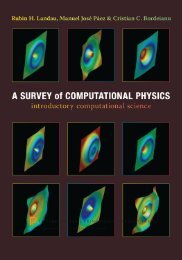Statistical Physics
Statistical Physics
Statistical Physics
- No tags were found...
Create successful ePaper yourself
Turn your PDF publications into a flip-book with our unique Google optimized e-Paper software.
160 10 Dense Gases – Ideal Gases at Low TemperatureIn order to obtain the magnetic susceptibility, we evaluate this integral up toonly the first order in B. We obtainM ≃ 1 2 (gµ B) 2 D(E F )B = 3 ( ) 2 12 2 gµ NB B. (10.45)E FThus the magnetic susceptibility per unit volume isχ = 3 ( ) 2 12 2 gµ µ 0 NB , (10.46)VE Fwhere µ 0 is the permeability of free space.10.4.2 Properties at Low TemperatureThe Fermi TemperatureAt nonzero temperatures, thermodynamic variables such as the internal energyand the magnetic susceptibility deviate from their values at T =0.Theamount of deviation depends on whether we consider the system at a fixednumber of particles or a fixed value of the chemical potential. Here, we calculatethe deviation at a fixed number of particles in the lowest order of thetemperature T . Since the Fermi distribution function is expressed in terms ofthe chemical potential, we first calculate how the chemical potential changesat nonzero temperature, and then calculate the temperature dependence ofthe internal energy, the heat capacity, and the magnetic susceptibility of thesystem at a fixed number of particles.In order to present the results in a transparent form, we need a naturalscale for the temperature. This scale is provided by the Fermi temperature T F ,which is defined as the Fermi energy divided by the Boltzmann constant k B :T F = E (F= 2 3π 2 Nk B 2mk B V) 2/3. (10.47)The Fermi energy or the Fermi temperature is a function of the particle densityN/V . If the conduction electrons in a metal are considered as free fermions,we can estimate the Fermi temperature of the metal. From the mass densityof the metal and the mass number of the constituent atoms, we can calculatethe number density of atoms. From the valence of the metal, we know howmany conduction electrons are provided to the metal by each atom. We canthen estimate the conduction electron density N/V . The effective mass m isusually of the order of the vacuum mass of an electron. So, by assuming thatthe effective mass is equal to the vacuum mass, we can estimate the Fermienergy and the Fermi temperature. For most metals, this procedure gives valuesof T F between 10 4 and 10 5 K. Some values of the Fermi temperature fortypical metals are given in Table 10.1. In this subsection, “low temperature”means that T ≪ T F . Therefore, metals at room temperature can be regardedas being in the low-temperature regime.











![Práctica [PDF] - Universidad de Carabobo, FACYT - computacion](https://img.yumpu.com/48491415/1/190x245/practica-pdf-universidad-de-carabobo-facyt-computacion.jpg?quality=85)




